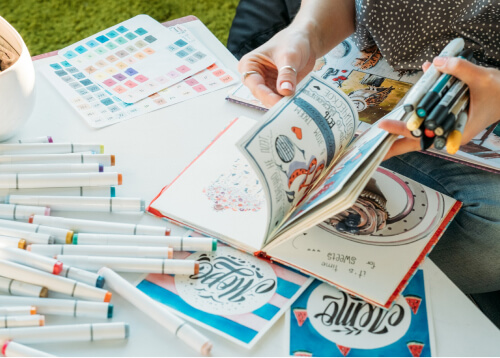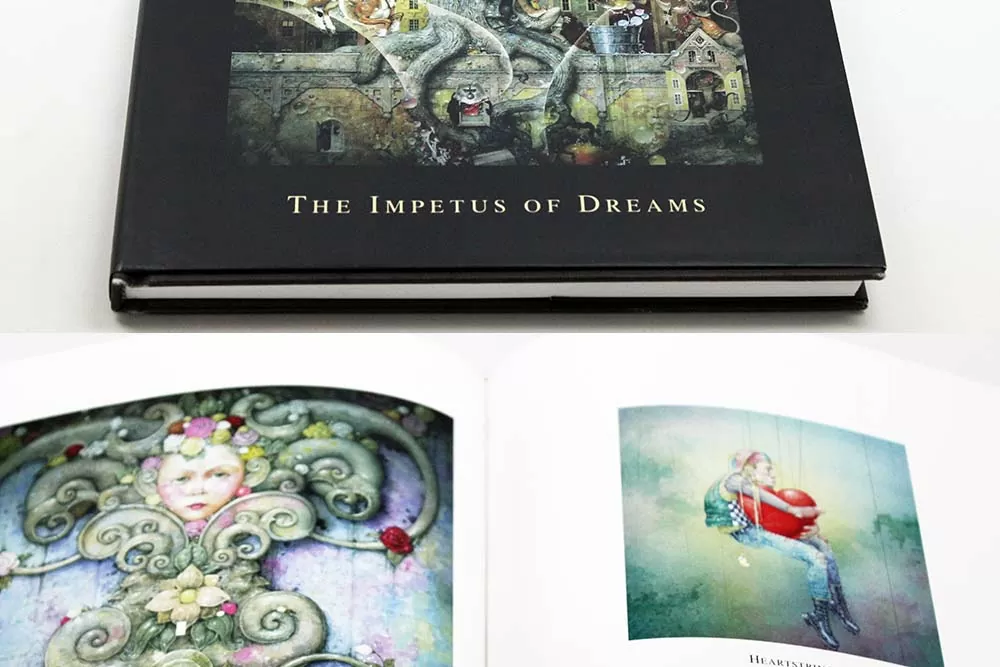Discover the Crucial Overview to Art Book Printing for Aspiring Artists and Publishers
As an aspiring musician or author, understanding the subtleties of art book printing is crucial to bringing your vision to life. What are the essential components you should concentrate on to create a sensational art book that absolutely represents your work?
Comprehending Different Kinds of Art Books
When you dive into the globe of art books, you'll promptly uncover that they are available in numerous forms, each customized to various creative expressions and target markets. Coffee table publications commonly display sensational visuals, excellent for laid-back browsing, while monographs dive deep right into a specific musician's job, providing context and insights. If you have an interest in particular art movements, event directories offer comprehensive paperwork of programs, featuring essays and critiques.
For instructional functions, art handbooks and method publications lead you with different tools and styles, making them necessary for aspiring musicians. Each style serves its function, and knowing their differences can enhance your art book trip.
Selecting the Right Paper and Products
Selecting the ideal paper and materials can greatly impact the overall quality and feeling of your art book. For lively shades and elaborate information, choose for a shiny coating or a heavyweight matte paper that improves visual deepness.
Think regarding the weight of the paper, too. Thicker alternatives usually provide an even more specialist appearance, while lighter documents can lower printing prices. Don't ignore the binding products; a sturdy cover can secure your web pages and contribute to the book's visual.
Ultimately, consider sustainability. Eco-friendly options are gaining popularity and can show your worths as a musician. By meticulously selecting your paper and products, you'll ensure that your art book not just looks wonderful but also really feels unique in the hands of your viewers.

Picking the Best Printing Methods
When it involves printing your art book, picking in between balanced out and electronic printing can greatly affect your last item. You'll likewise intend to take into consideration exactly how paper quality influences the general feel and look of your art work. Let's discover these crucial printing techniques to discover the very best suitable for your project.
Balanced Out vs. Digital Printing
While both balanced out and electronic printing have their advantages, selecting the appropriate strategy for your art book can greatly impact the final product. Balanced out printing uses high-grade images and vibrant colors, making it optimal for larger print runs. Eventually, your option must line up with your creative vision and circulation method, making sure that your art book mirrors the high quality you prefer.
Paper High Quality Considerations
Choosing the appropriate paper top quality can considerably enhance the aesthetic charm and tactile experience of your art book. For prints, a shiny surface can make images pop, while a matte coating offers a softer, more refined look.
Following, think of the sustainability of your option. Environment-friendly options are coming to be progressively popular and can attract environmentally-conscious readers. Ultimately, request examples to see how various documents collaborate with your artwork, ensuring the end product mirrors your vision completely.
Guaranteeing Shade Accuracy in Your Prints
To accomplish stunning prints, you need to concentrate on color accuracy from the beginning. You'll wish to utilize shade calibration techniques to verify your display and printer are in sync. Furthermore, proofing your job before the final print run can assist capture any inconsistencies, assuring your art looks equally as you imagined.
Shade Calibration Techniques
Guaranteeing shade precision in your prints begins with efficient color calibration techniques that aid keep uniformity between your digital photos and last printed products. Next off, pick a shade profile matched for your printing procedure, like CMYK for print materials. By regularly applying these strategies, you'll improve the general quality of your art prints and far better share your creative vision.
Proofing for Accuracy
While you might assume your digital photos are ready for print, proofing is crucial for accomplishing shade accuracy. Prior to committing to a complete print run, constantly request an evidence from your printer.
If adjustments are required, connect clearly with your printer concerning your desired results. Don't think twice to demand multiple proofs if essential; it's worth the investment to obtain it. Ultimately, thorough proofing assurances that your art work is represented as you imagined it, keeping your artistic stability throughout the printing procedure.

Designing Layouts That Enhance Your Artwork
When you create formats for your art book, it's essential to contemplate how each aspect communicates with your artwork. Go for an equilibrium in between visuals and text, making sure neither outweighes the various other. Usage white area tactically; it provides your artwork room to breathe and draws focus to its information.
Take into consideration the circulation of your book. Set up pictures in a manner that guides the reader's eye, creating a story or thematic development. art book. Vary the sizes and orientations of your art work to maintain the design dynamic and interesting
Select fonts that match your artwork without distracting from it. Maintain message concise and relevant, providing context or understanding that improves the audience's experience.
Finally, examination various layouts. Publish examples to see how the designs convert on paper, and adjust as required. By thoughtfully designing your formats, you'll produce a visually interesting art book that resonates with your audience.
Binding Choices for a Professional Finish
Selecting the right binding option can greatly influence the general presentation of your art book. You'll wish to think about both visual appeals and resilience when making your selection. Popular choices consist of ideal binding, which offers a streamlined look and is best for thicker books; saddle sewing, ideal for smaller sized booklets; and spiral binding, which enables pages to lay flat for simple viewing.
If you're going for a costs feeling, instance binding is a superb selection, providing a sturdy cover and a professional appearance (art book). Don't ignore the cover material; alternatives like cloth, natural leather, or a shiny finish can raise your book's appeal
Whatever choice you pick, see to it it matches your art work and enhances the visitor's experience. Take your Source time to consider the advantages and disadvantages of each method, so your end product reflects the high quality of your imaginative vision.
Preparing Your Declare Print Readiness
To assure your art book is print-ready, you'll i thought about this require to pay close focus to file preparation. Begin by establishing your document size to match your preferred print dimensions. Use high-resolution pictures-- 300 DPI is the criterion-- to ascertain sharp, dynamic visuals. Transform your documents to CMYK setting, as this shade space is best for printing. Don't forget to include bleed locations, generally an added 0.125 inches around your web pages, to stop any type of white edges after trimming.
Think about creating a proof to assess before the final print run. Adhering to these actions will aid you attain a refined, professional art book.
Regularly Asked Concerns
What Is the Average Price of Publishing an Art Book?
The average price of printing an art book varies, yet you can expect to pay anywhere from $5 to $20 per duplicate, relying on elements like dimension, paper top quality, and printing volume.
How Can I Discover a Reliable Printing Company?
To find a dependable printing firm, begin by researching on-line reviews and asking other artists for referrals. Compare quotes, examine profiles, and communicate your requirements clearly to ensure they understand your vision and high quality expectations.
What Is the Normal Turn-around Time for Printing?
The common turn-around time for printing varies however usually ranges from one to 4 weeks. Elements like task complexity and quantity can affect this. Always validate with your chosen printer for certain timelines and assumptions.
Can I Print My Art Book in Limited Quantities?
Yes, you can most definitely print your art book in restricted amounts. Numerous printing business supply short-run options, enabling you to generate just the number you need, making it much easier to manage costs and stock.
What Lawful Factors To Consider Should I Know for My Art Book?
You should think about copyright, licensing arrangements, and version releases when creating your art book. Ensure you deserve to make use learn this here now of all images and text, safeguarding on your own from possible legal concerns in the future.